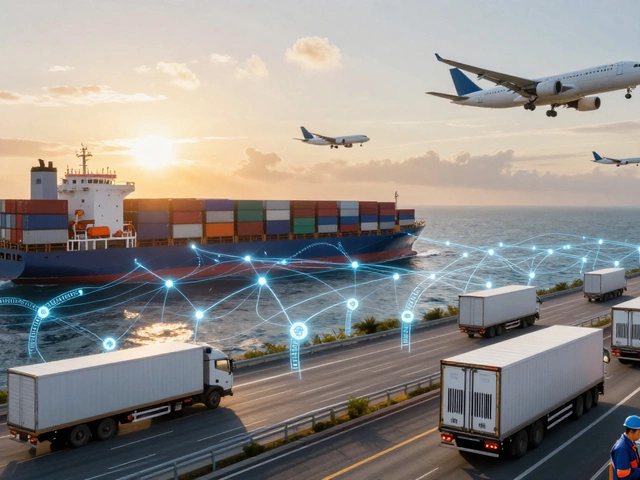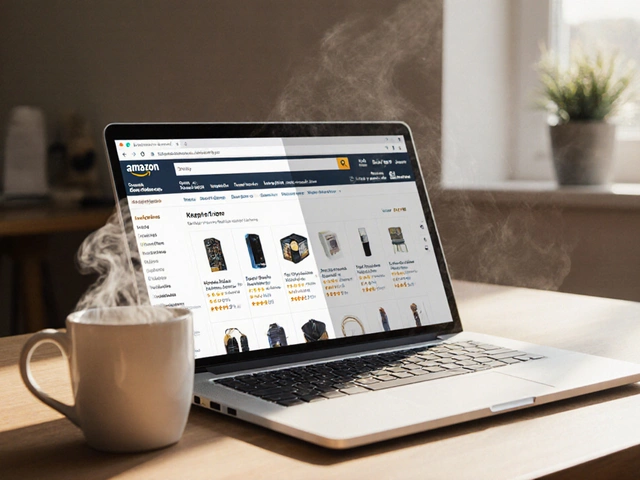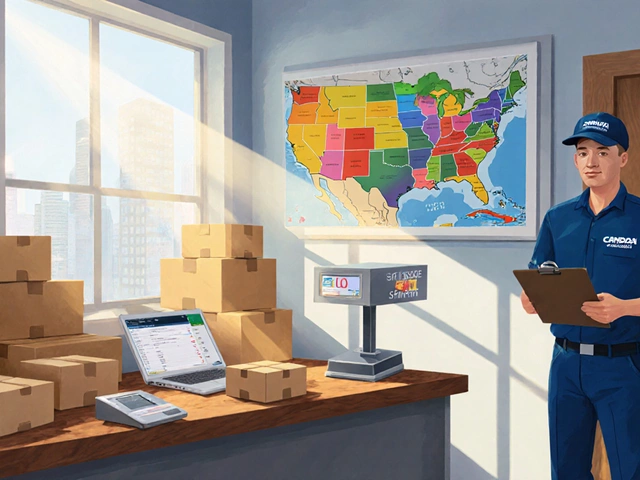You want a straight answer: is Amazon a 3PL or a 4PL? Short version-Amazon is primarily a 3PL through FBA and MCF. With Supply Chain by Amazon (AWD, Global Logistics, Freight), it can behave like a 4PL inside its own network. That matters, because your choice affects delivery speed, cost control, and how much power you hand over to a single platform.
- Amazon acts mostly as a 3PL (FBA/MCF) that stores, picks, packs, and ships your goods.
- “Supply Chain by Amazon” bundles upstream logistics (global freight, bulk storage) so it can feel 4PL-like-but it’s not a neutral orchestrator.
- If most revenue is Amazon marketplace, Amazon-as-3PL is hard to beat for speed and conversion.
- If you need cross-channel control and vendor orchestration, a true 4PL or hybrid setup wins.
- Watch 2025 fee changes and inventory policies; those can tip the math fast.
3PL vs 4PL in 2025: What the labels actually mean
Let’s strip the jargon. A 3PL (third-party logistics) is the hands and feet: warehousing, pick/pack, shipping, maybe returns. Think execution. They run the buildings and trucks so you don’t have to. ShipBob, Ryder, GXO, and yes-Amazon’s FBA/MCF-fit here.
A 4PL (fourth-party logistics) is the quarterback. It doesn’t have to own warehouses or trucks. It orchestrates multiple 3PLs and carriers, manages inventory flow end to end, optimizes cost-to-serve, and gives you a “control tower” view. It’s your single point of contact for the whole network. Accenture’s 4PL services, DB Schenker’s 4PL, and some Flexport programs play this role. In B2B, some call it LLP (lead logistics provider).
Core differences that affect your decision:
- Scope: 3PL executes parts of the chain; 4PL designs and runs the entire chain, often multi-3PL and multi-carrier.
- Neutrality: 3PLs sell their own capacity. 4PLs should be neutral, picking the best combo of providers for you.
- Control: 3PL = you adapt to their network. 4PL = the network adapts around your strategy.
- Data layer: 3PL gives operational dashboards. 4PL offers network-level planning, S&OP tie-in, and scenario modeling.
- Contracts: 3PL = service-level contracts per node. 4PL = master governance, the 4PL manages vendors and KPIs.
Two quick rules of thumb:
- Rule of Channels: Single dominant channel (e.g., Amazon.com) → you can lean 3PL. Two or more meaningful channels → you’ll want 4PL-like orchestration.
- Rule of Complexity: Fewer than 500 SKUs, parcel-heavy, North America only → 3PL simplicity wins. Complex catalog, multi-region, wholesale + DTC mix → 4PL gains rise.
Where Amazon fits: FBA, MCF, AWD, Freight, and the 4PL-like bundle
Amazon wears multiple hats. Most of the time, it’s a 3PL. Sometimes, with the right bundle, it behaves like a 4PL-but only inside Amazon’s ecosystem.
Here’s how the main programs map in 2025:
- Fulfillment by Amazon (FBA): Classic 3PL. You ship inventory to Amazon; they store, pick, pack, deliver, and handle customer service and returns for Amazon orders. Prime badge drives conversion; fees and storage policy changes drive your margins.
- Multi-Channel Fulfillment (MCF): Still 3PL. Same network, but you can fulfill Shopify/BigCommerce/own-site orders. No Prime badge off-Amazon, but fast service levels. Useful as a single-warehouse alternative.
- Amazon Warehousing & Distribution (AWD): Upstream bulk storage in Amazon facilities, pre-positioned to feed FBA/MCF. Execution layer, but part of a broader “supply chain by Amazon” approach.
- Amazon Global Logistics: Ocean and air freight from origins (often Asia) to Amazon’s US/EU networks. That’s transportation execution-again, 3PL activity in scope.
- Amazon Freight: Linehaul/LTL/FTL services (varies by region) that can move pallets between nodes. Still transportation execution.
- Amazon Shipping: Parcel carrier service for your external orders (availability varies by country). Acts like a carrier, not a 4PL.
- Supply Chain by Amazon: The bundle-origin freight → AWD → FBA/MCF-plus placement and replenishment automation. This is where it starts to feel 4PL-ish, because Amazon plans and moves your inventory through its network with minimal touchpoints.
So is this 4PL? Close, but not quite. A true 4PL picks from multiple 3PLs and carriers and remains vendor-neutral. Amazon’s orchestrator is great-inside Amazon’s own stack. It won’t pick your local Toronto 3PL for Canadian DTC while also feeding U.S. wholesale with a different provider. It will use Amazon capacity, policies, and SLAs.
Context for 2025 (citing primary sources):
- Amazon Accelerate 2023 announced “Supply Chain by Amazon” expansion, tying AWD, Global Logistics, and FBA together.
- Seller Central 2024-2025 fee updates added placement and storage utilization surcharges that change the landed cost math for FBA inbounding and aged inventory.
- Amazon Shipping expanded in the U.S. in 2024 for non-Amazon orders; availability outside the U.S. is region-specific and evolving in 2025.
Bottom line: Amazon is a best-in-class 3PL for Amazon orders, a solid 3PL for non-Amazon orders via MCF, and an almost-4PL when you buy the full bundle-inside a walled garden.
| Dimension | Traditional 3PL | True 4PL | Amazon (FBA/MCF/AWD) |
|---|---|---|---|
| Primary role | Execute warehousing & fulfillment | Design/orchestrate whole network | Execute in Amazon network; auto-orchestrate within it |
| Neutrality | Low-medium (own ops) | High (vendor-agnostic) | Low (Amazon-first capacity) |
| Channel scope | Multi-channel | Multi-channel | Amazon-native; MCF for external |
| Geography | Depends on provider | Global, multi-provider | Strong in US/EU; regional variance elsewhere |
| Control tower | Limited | Yes (network-level) | Yes, but within Amazon’s stack |
| Capex/Setup | Low-medium | Medium-high (program + governance) | Low (self-serve), fees tied to policies |
| Best for | Simple to moderate ops | Complex, multi-node ops | Amazon-heavy businesses; speed-to-Prime |
| Main risks | Capacity, SLAs vary | Vendor lock-in to orchestrator | Fee volatility, platform dependency |

Decision guide: When to treat Amazon as 3PL vs 4PL
Here’s a quick decision path you can run in 10 minutes.
- Revenue mix check: If 60%+ of your revenue is Amazon marketplace, prioritize FBA for those SKUs. The Prime conversion lift often outweighs higher fees.
- Channel map: If you have 2+ meaningful non-Amazon channels (Shopify, retail, B2B), list their service levels (2-day, 3-5 day, international) and return rules.
- SKU profile: Note dimensions, seasonality, and cube. High-cube and slow movers hurt in FBA due to storage and aged-inventory surcharges-consider AWD + periodic feeds or non-Amazon 3PLs for those.
- Geography: If you sell in US, Canada, and EU, decide if you need local stock in each market. For Canada specifically, weigh cross-border duty/taxes vs local FBA.ca or a Canadian 3PL for DTC.
- Control appetite: Do you need carrier choice, branded packaging, custom kitting, or wholesale prep? If yes, pair Amazon with a 3PL/4PL that covers the bespoke work.
- Resilience: If Amazon paused inbound or tweaked placement fees (it happens), what’s your Plan B? If you don’t have one, you’re overexposed.
Heuristics that rarely fail:
- Prime-first rule: If a SKU moves fast on Amazon, keep it in FBA. Use AWD only if you regularly stock out due to long lead times.
- Margin guardrail: If FBA fees push landed fulfillment cost above 18-22% of selling price for a stable SKU, model MCF or a non-Amazon 3PL for non-Amazon orders.
- Two-network hedge: For any SKU driving 10%+ of revenue, keep a dual path (Amazon + one external 3PL) so a single policy change doesn’t knock you offline.
Common scenarios:
- Amazon-led DTC brand (1-300 SKUs): Treat Amazon as your primary 3PL (FBA for Amazon orders, MCF for your store). Add a small regional 3PL for custom kits or VIP packaging you can’t do in FBA.
- Omnichannel consumer brand (500-5,000 SKUs): Use a true 4PL or internal control tower to orchestrate multiple 3PLs. Keep a carve-out of fast movers in FBA for the Prime halo; place long-tail in external 3PLs.
- Wholesale-heavy with retail compliance: You need specialized prep and routing guides. Keep Amazon marketplace SKUs in FBA; handle retail/EDI via a 3PL that lives and breathes retail compliance.
Cost and SLA realities to model in 2025:
- FBA fees: Core pick/pack, inbound placement, storage (higher Oct-Dec), aged inventory surcharges, dimensional weight rules, and category-specific returns fees.
- MCF fees: Per-unit fulfillment rates by size/tier, optional unbranded packaging, and different SLAs than Prime.
- AWD: Lower carrying cost than FBA storage for slow movers; extra handling when moving stock into FBA bins.
- Global Logistics: Competitive door-to-port/port-to-network rates, but you’re betting on Amazon’s routings and ETAs.
What about Canada? If you’re selling on Amazon.ca, FBA.ca gives fast delivery nationwide; just note regional placement and inbound options. For DTC in Canada, MCF can work, but availability of Amazon Shipping as a stand-alone parcel service is still region-dependent in 2025. Many Canadian brands run a hybrid: FBA for Amazon.ca, a domestic 3PL for DTC, and FBA or a U.S. 3PL for Amazon.com.
If you only remember one sentence, it’s this: Use Amazon as a world-class 3PL where it shines, and use a 4PL or external 3PLs to protect margins and keep control across the rest of your network.
Examples, checklists, and what to do next
Three quick examples to anchor the call:
- Lean DTC brand (Toronto → US & Canada): Keep top 50 SKUs in FBA for both .com and .ca. Feed FBA from AWD to smooth seasonality. Use a local 3PL for site orders that need custom inserts and for retail pilot orders. Result: Prime speed plus brand control off-Amazon.
- Outdoor gear company (North America + EU): FBA for Amazon’s top movers. EU operations via a regional 3PL that handles returns and repairs. A 4PL oversees inventory positioning and carrier mix between continents. Result: Balanced service and cost across markets.
- Beauty brand with heavy promos: Keep promo bundles and gift sets out of FBA due to packaging rules; run them through a flexible 3PL. Keep core SKUs in FBA for Prime. When promos start, flip MCF on for site orders to avoid stockouts at your 3PL. Result: Agility without losing Prime lift.
Quick checklist-should I treat Amazon as my 3PL for this SKU?
- SKU drives meaningful Amazon volume (ranked in your top 20% on Amazon).
- Margins can absorb FBA + storage fees at current price point.
- No special packaging, inserts, hazmat, or kitting that FBA can’t support.
- Forecast is stable enough to avoid long-term storage penalties.
- You have a backup path (external 3PL) if fees or inbound policies shift.
Quick checklist-do I need a 4PL or control tower?
- You sell across 3+ channels (Amazon, DTC, retail/wholesale) and 2+ regions.
- You need one view of inventory and ATP across all nodes.
- You want vendor/carrier optimization beyond a single provider’s network.
- Your leadership wants scenario planning (what-if on cost, speed, CO2).
- You’ve had stockouts or excess inventory because providers don’t coordinate.
Mini-FAQ
- Is Amazon a 3PL? Yes. FBA/MCF are classic 3PL services-storage, fulfillment, shipping, and returns.
- Is Amazon a 4PL? Not in the strict, vendor-neutral sense. “Supply Chain by Amazon” is an orchestrated 3PL bundle within Amazon’s own network.
- Can Amazon be my only logistics provider? For Amazon-first brands, often yes. But for multi-channel brands, you’ll likely pair it with at least one other 3PL or a 4PL.
- What changed in 2024-2025? Placement and storage-related fees got more granular; Amazon Shipping expanded in the U.S.; AWD and Global Logistics tightened the end-to-end loop.
- What’s the risk of going all-in on Amazon? Fee volatility, inventory policy shifts, and limited brand control off-Amazon. Build a hedge.
Next steps if you’re Amazon-heavy:
- Tag your top 100 Amazon SKUs by margin and cube. Push the top movers into FBA; keep slow bulky items in AWD or an external 3PL.
- Turn on MCF for your store and measure delivery time and cost for 30 days.
- Model fee scenarios: +10% FBA fee, +20% storage, +1-week inbound delay. If profit collapses, add a second 3PL now.
- Document non-standard needs (bundles, inserts) and route those SKUs outside FBA.
Next steps if you’re multi-channel and global:
- Map your nodes and flows: origins → inbound → storage → fulfillment → returns. Highlight which nodes are Amazon vs non-Amazon.
- Pick a 4PL or build a light control tower in-house (OMS + WMS + TMS) to coordinate providers.
- Keep a strategic FBA carve-out for Prime lift; use external 3PLs for long-tail, wholesale, and custom packaging.
- Set quarterly business reviews across providers with one shared scorecard (fill rate, OTIF, cost/order, aging, returns).
Common pitfalls to avoid:
- Sending slow movers to FBA in Q4 and eating punitive storage fees.
- Relying on one inbound path; when placement rules change, your lead time balloons.
- Ignoring packaging rules and getting stranded inventory.
- Letting Amazon handle everything and discovering your DTC brand is invisible in the unboxing.
Pro tips:
- Use AWD as a buffer only if it stabilizes your in-stock rate by at least 2-3 points; otherwise, it’s just another storage bill.
- Track cost-to-serve per SKU weekly. If a SKU’s FBA cost jumps above your 22% threshold, reroute a portion to MCF or your 3PL.
- Run small A/B tests: MCF vs your 3PL for the same DTC SKU over 30 days. Keep the winner for that lane.
- Automate your dual-path plan: If FBA days of cover drop below X, unlock MCF for your store; when replenished, switch back.
One last clarity check on the label question: calling Amazon a 4PL gives the wrong impression. A true 4PL is network-agnostic and sits above the providers. Amazon is a high-performance executor with an increasingly integrated stack. Use it as such-and use a 4PL when you need orchestration across multiple providers and channels. If you’re optimizing for Prime, that’s where Amazon 3PL shines.





